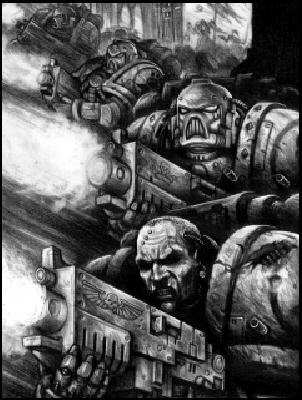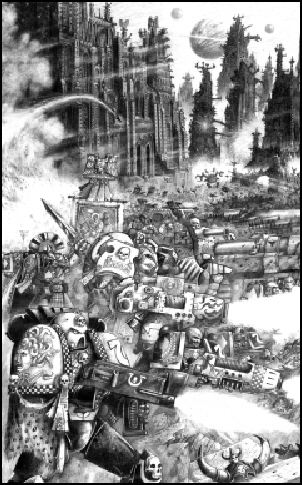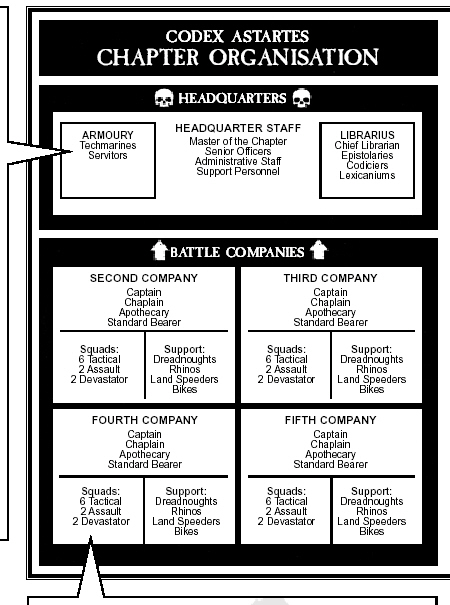CODEX ASTARTES
The Holy Tome of the Space
Marines
The Codex Astartes describes the organisation, tactical operation and countless other aspects of Space Marine doctrine. Subjects as diverse as religious instruction and strategic supply are all covered in great detail within its thousands of holopages. Over the following pages we will look at the origins of this ancient tome and also how it states a Space Marine Chapter should be organised.
They would allow the Emperor to possess the galaxy for a fleeting moment only. He would be encouraged to stretch his empire further and further from Terra, until his forces were scattered thinly along the galactic fringe. Then the dark gods would strike and crush the Emperor with one swift blow. When rebellion erupted, Horus led more than half of the Space Marine Legions into the bloodiest civil war ever to engulf the galaxy and laid siege to the Emperor’s Palace. It would take many pages to describe the battle for Earth, suffice to say the war ended when the Emperor teleported onto Horus’s battle barge and slew the Warmaster in single combat. The titanic struggle saw the Emperor mortally wounded and from that moment on he ceased to live in the conventional sense. Rogal Dorn, Primarch of the Imperial Fists discovered the Emperor’s dying body and carried it back to Earth where he was interred in the life preserving mechanism of the Golden Throne. And for ten thousand years since that day, the Emperor has ruled immobile and immortal from the throne of Earth. Though the Horus Heresy was at an end, the galaxy was in turmoil once more. The armies of the Imperium were destroyed or scattered and worst of all, the Emperor could no longer walk amongst his warriors. The leadership and guidance he had given humanity for thousands of years was suddenly absent. To lead mankind, a council was formed of the twelve most powerful individuals in the Imperium. They became known as the High Lords of Terra, and their role was to rule the Imperium on behalf of the Divine Emperor.
The newly created High Lords established the organisation of the Imperium that remains familiar to this day. The first High Lords laid down the structure by which the Adeptus Terra operates, and described the feudal responsibilities and duties of planetary lords. One of their most important accomplishments was the reorganisation of the Imperium’s armed forces. This task was undertaken almost singlehandedly by the Primarch of the Ultramarine Legion of Space Marines, Roboute Guilliman, who quickly and efficiently codified the structure of the Imperial Guard, the Fleet and the Space Marines. Of all his works the most influential is the Codex Astartes, the great prescriptive tome that lays down the basic organisational and tactical rules for Space Marines. The Horus Heresy had revealed weaknesses in the geneseed of several Space Marine Legions which had been exaggerated by the accelerated zygote harvesting techniques needed to keep the huge Space Marine Legions up to strength. The powers of Chaos exploited this growing physical and mental corruption to turn Horus’s troops against the Emperor. The prime objective of the new Codex Astartes was to recognise and expunge these weaknesses. The Codex decreed that Space Marines would be created and trained over a controlled period of time. The genetic banks used to cultivate implants would be carefully monitored and cultivated organs would be subject to the most stringent tests of purity. Young initiates would undergo rigorous trials of physical and psychological suitability before they were accepted, and only those of the highest calibre would be chosen.
On Earth the Adeptus Terra created genetic repositories to produce and store Space Marine gene-seed. These banks were used to provide all new gene-seed for Space Marines, and, to prevent cross-contamination, the genetic material of each of the old Legions was isolated. Henceforth the new Space Marine Chapters would receive gene-seed only from their own genetic stock. The gene-seed of the Traitor Legions was placed under a time-locked stasis seal, although at the time many believed these dangerous gene stocks should be destroyed. By taking direct control of the genetic stocks, the Adepts on Earth could ultimately control the Space Marines. Now they alone had the power to destroy or create Space Marine armies at will. The Second Founding of the Space Marines was decreed seven years after the death of Horus. The existing Space Marine Legions were broken up and refounded as smaller, more flexible formations. Where the old Legions were unlimited in size, the new formations were fixed at approximately one thousand fighting warriors. This corresponded to the existing unit called the Chapter, and in future the Chapter was recognised as the standard autonomous Space Marine formation. No longer would one man have power over a force as powerful as a Space Marine Legion.
As a result of the Second Founding the Ultramarines’ geneseed became the favoured gene-seed of most subsequent foundings. The new Chapters created from the Ultramarines are often referred to as the Primogenitors, or ‘first born’. All the Primogenitor Chapters venerate Roboute Guilliman as their founding father and patron. The Codex Astartes further defines the tactical roles, equipment specifications and uniform identification markings of the Space Marines. These guidelines have evolved over the centuries, and the Codex Astartes of the forty first millennium is a highly developed treatise combining the wisdom of hundreds of military thinkers throughout history. Some of its contents seem petty and restrictive, hardly worthy of the great mind of the Primarch. Others describe actual battles together with comments on the tactics employed and the decisions of the commanders of the day. As such the Codex Astartes is revered as a holy text, and many Chapters regard its recommendations as sanctified by the Emperor himself. The Chapters that rigidly follow the recommendations of the Codex Astartes are sometimes referred to as Codex Chapters. These Space Marines adhere to the Codex as the model for their organisation, identification markings and tactical doctrine. Of all the Codex Chapters the most famous is the Ultramarines, the Chapter of Roboute Guilliman himself, and many of the other Codex Chapters are descended from their genetic line.
Most Chapters, however, do not stick so rigidly to the Codex patterns laid down either for organisation, tactical roles or other processes. Many Chapters are largely organised according to the Codex but are further shaped by their home world and the personality of their Primarch. The Blood Angels and Dark Angels are prime examples of this. A small number of Chapters are vastly different from the Codex, and owe nothing at all to it. The most famous of these ‘wild’ Chapters are the Space Wolves, whose strongwilled Primarch, Leman Russ, moulded his Chapter very much in his own image irrespective of other influences. The Adeptus Terra has never felt it necessary to enforce the Codex absolutely. Indeed it is doubtful whether it could. However, with subsequent foundings they have always favoured the Ultramarines' gene-seed and created new Codex Chapters from their line. With the passage of time, some of these Chapters have subsequently strayed from the strict letter of the Codex, introducing new variations but remaining broadly faithful to the principles laid down by Roboute Guilliman many thousands of years before. The history of the Imperium since the Heresy is not a continuous story. There have been periods of rebellion and anarchy, times when the balance of power has suddenly changed and history has been quite literally rewritten. Many of the subsequent foundings of Space Marines belong to these troubled times, making it almost impossible to be certain when some Chapters were created or even how many Chapters have been created at all. It is believed that there are approximately a thousand in existence today, scattered throughout the galaxy. Of these more than half are descended from the Ultramarines, either directly or through one of the Primogenitor Chapters of the Second Founding. It is not certain how many new Chapters were created by the Second Founding. Many Imperial records were lost during the Age of Apostasy, a troubled time that lies across the history of the Imperium like an impenetrable veil. In all likelihood some of the Chapters created during the Second Founding have since been destroyed leaving no record of their deeds. Others have been lost in more recent times and their names are now all that remain of them. Following the Horus Heresy the Space Marine Legions were divided into Chapters consisting of roughly a thousand warriors. A large section of the Codex Astartes is dedicated to structuring the organisation of these Chapters. A Chapter consists of ten Companies each numbering 100 Space Marines. A Company consists of ten squads of ten men including a Sergeant. In addition to this basic fighting unit, each company has its own Captain, Standard Bearer, Chaplain and Apothecary. Every Company with the exception of the Scout Company maintains Rhino transports for their squads and officers. The 1st Company is also equipped with Land Raiders to carry Terminator squads. It is customary for Dreadnoughts to remain with their Company as their fearsome presence bolsters the Company’s fighting strength.
According to the Codex Astartes, Space Marines are organised into three different types of squad: Tactical, Assault and Devastator. Each of these squads has a unique battlefield role and are designed to operate together to provide mutual support and maximum flexibility. In addition to these three squads the Ist (Veteran) Company can be formed into Terminator or Veteran squads while the Scouts are always fielded as Scout squads. Tactical squads are the most commonly found squad in a Chapter. A Tactical squad is led by a Sergeant and includes nine other Space Marines. Of these, seven Space Marines are armed with boltguns, whilst the remaining two can be armed with boltguns or, alternatively, one may carry a heavy weapon and the other may carry a special weapon. This combination is the most tactically flexible and offers a good mixture of capabilities within the squad. Assault squads are specialists at fighting in hand-tohand combat. Each squad consists of a Sergeant and nine Space Marines equipped with jump packs and armed with a close combat weapon in each hand. Common armament consists of a bolt pistol and chainsword. Optionally, two of the Space Marines may carry plasma pistols. This combination is ideal for fastattacking, close-quarter fighting assault troops. Devastator squads consist of a Sergeant and nine Space Marines. Up to four Space Marines may be armed with heavy weapons, whilst the remainder will carry boltguns. This is the most heavily armed type of Space Marine squad of all and they are deployed wherever extra fire-support is needed, especially when the Chapter faces enemy tanks or fortified positions. Terminator squads wear the uniquely powerful Terminator armour. This is massive in construction virtually turning a Space Marine into a one-man tank. Every Chapter has a limited number of Terminator armoured suits, and each is an ancient artefact crafted many thousands of years ago. Terminators are less mobile than other Space Marines and are primarily used in boarding actions or at extreme close quarters when heavy firepower cannot be brought to bear. Veteran squads are organised exactly like the Tactical squads of the Battle Companies. The Sergeant and the nine Space Marines are all Veterans. These squads are rarely deployed en masse but are sometimes used to strengthen an attack or provide the Chapter with flexible, hard-hitting reserves. Scout squads consist of a Space Marine Sergeant and four Scouts. The role of the Sergeant is to train the Scouts and lead them in battle. Only Sergeants of considerable experience and status are designated for this role. All Space Marine squads with the exception of the Scouts are nominally of ten troopers, but can be divided into two separate battle squads in combat. This gives each unit a further degree of flexibility in action. |
 Of
the original twenty Primarchs, Horus was the greatest and most beloved
of the Emperor and so was appointed his Warmaster. He was placed in
charge of the entire northeastern battlefront of the Great Crusade and
only Lion El’ Jonson and Leman Russ approached his tally of victories.
Little did the Emperor know that Horus really served a darker master.
The gods of Chaos, malevolent beings from the warp, had corrupted Horus
and his armies, turning them from the Emperor’s light. Their plan
was a foul and devious one.
Of
the original twenty Primarchs, Horus was the greatest and most beloved
of the Emperor and so was appointed his Warmaster. He was placed in
charge of the entire northeastern battlefront of the Great Crusade and
only Lion El’ Jonson and Leman Russ approached his tally of victories.
Little did the Emperor know that Horus really served a darker master.
The gods of Chaos, malevolent beings from the warp, had corrupted Horus
and his armies, turning them from the Emperor’s light. Their plan
was a foul and devious one. The
existing Space Marine Legions were divided into new Chapters, one Chapter
keeping the name and colours of the original Legion, while the remaining
Chapters would take new titles and colours. Most of the old Legions
divided into fewer than five Chapters, (the Space Wolves divided into
only two) but the Ultramarines were divided many times. The exact number
of new Chapters created from the Ultramarines is uncertain: the number
listed by the oldest known copy of the Codex Astartes (the so-called
Apocrypha of Skaros) gives the total as twenty three, but does not name
them.
The
existing Space Marine Legions were divided into new Chapters, one Chapter
keeping the name and colours of the original Legion, while the remaining
Chapters would take new titles and colours. Most of the old Legions
divided into fewer than five Chapters, (the Space Wolves divided into
only two) but the Ultramarines were divided many times. The exact number
of new Chapters created from the Ultramarines is uncertain: the number
listed by the oldest known copy of the Codex Astartes (the so-called
Apocrypha of Skaros) gives the total as twenty three, but does not name
them.

